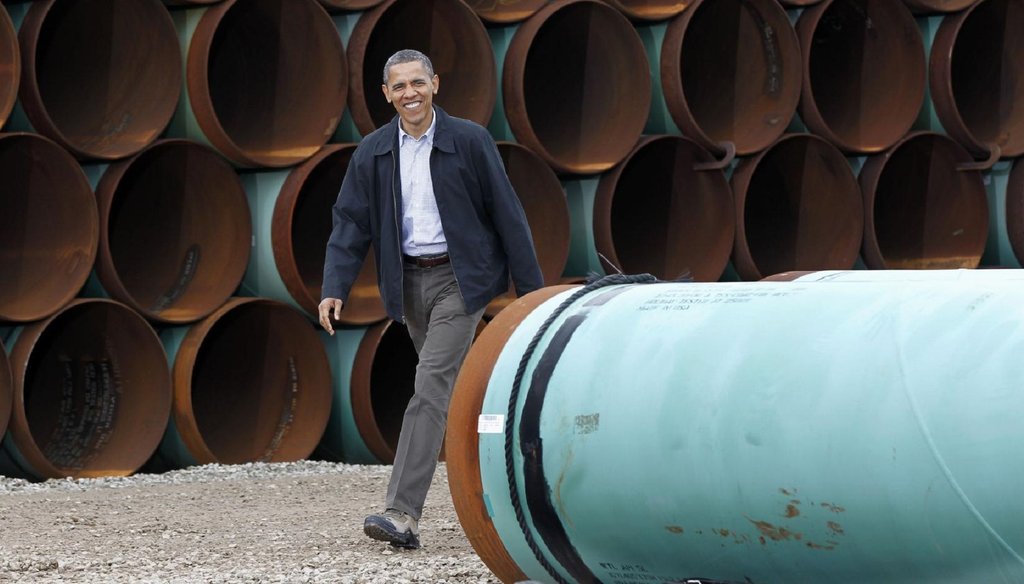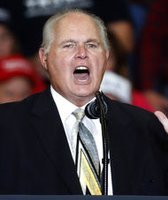Get PolitiFact in your inbox.

In 2012, President Barack Obama toured the TransCanada Stillwater Pipe Yard in Cushing, Okla. (AP file)
As one of the first acts of the 114th Congress, Republicans are committed to passing a bill that would permit construction of the Keystone XL oil pipeline from Canada through the United States. But if the bill passes, the White House has said President Barack Obama wouldn’t sign it, claiming that this particular responsibility lies with the Executive Branch, not Congress.
As the showdown plays out, we wanted to answer to three key questions you might have about the Keystone XL proposal.
SUPPORT POLITIFACT'S KICKSTARTER TO LIVE FACT-CHECK THE 2015 STATE OF THE UNION.
What is it?
The 875-mile Keystone XL pipeline would carry heavy crude oil mixture from Western Canada to Steele City, Neb. Then, it would connect with an existing southern leg that opened in early 2014, delivering more than 800,000 barrels of oil to refineries on the Gulf Coast. TransCanada, the pipeline operator, expects the project to cost $8 billion and to take one or two years to construct.
It has long been on hold pending a review by Obama and the State Department, which must determine if the pipeline "serves the national interest" because it crosses an international border.
Over the years, more than anything else, it’s become a symbolic debate about fossil fuels. The pipeline has bipartisan support in Congress and among the public, with many touting job creation and smart-energy strategy -- replacing some of America’s oil imports from other continents with oil imports from a friendly neighbor.
However, two left-wing constituencies are pitted against each other over Keystone: with labor unions in support, and environmentalists saying it would contribute to climate change and wouldn’t create enough jobs to be worth it.
TransCanada’s intention in building the pipeline is to export their oil. Although some critics in the United States, such as Obama, have said there’s not much to be gained from allowing Canada to use the American Midwest as an easy path to the Gulf Coast, where they can reach markets beyond North America. However, there’s a consensus among experts that American refineries will be the primary purchasers of oil transported through the pipeline. We rated Obama’s claim on this Mostly False.
What’s the environmental impact?
Critics who say the pipeline would harm the environment don’t as much have of an issue with the pipeline itself as they do with what it transports.
The oil would come from the tar sands of Canada’s boreal forests. Extracting this type of dirty, thick crude oil is energy-intensive and produces a significant amount of carbon emissions. Critics say that Keystone XL will elevate greenhouse gas emissions and contribute to climate change by encouraging expansion of the tar sand development. Also, if it leaks, the oil is corrosive and difficult to clean up.
The most-often cited report about Keystone XL’s potential environmental impact is an 11-volume State Department document that said the project is "unlikely to significantly impact the rate of extraction in the oil sands." In other words, the pipeline would not significantly contribute to carbon pollution -- Canadian officials and oil producers vow that the oil will be extracted and reach the American marketplace by other means.
Conservative activist Ralph Reed said the State Department report shows "the science is clear" that "alternatives to the pipeline are worse" for the environment
The State Department report considered three reasonable alternatives to the pipeline -- rail, tankers and a combination of rail and existing pipeline -- and all had a higher environmental impact than Keystone XL.
However, this isn’t to say that the project would be entirely without negative environmental impact. Reed’s statement dismisses the fact that the project would generate more greenhouse gases than the alternative desired by environmentalists: doing nothing to expand tar sands production. We rated Reed’s statement Half True.
How many jobs will the Keystone XL pipeline create?
Despite Keystone XL supporters waxing lyrical about the prospect of thousands of new jobs, the employment picture isn’t so rosy. In short, the State Department expects that the project would only result in only a few permanent jobs that last past construction.
Many proponents, like TransCanada CEO Russ Girling, say the project will create 42,000 jobs. Girling said these jobs would be "ongoing, enduring," and we rated that claim False.
The State Department report does puts the total number of jobs at 42,100 -- but the definition of a job in this sense is a position filled for one year. This total reflects both jobs created directly as a result of construction and manufacturing for the pipeline -- about 3,900 annual positions over two years -- as well as spin-off jobs supported by construction workers who purchase materials for the project or spend their wages in the economy. Much of the construction work would come in four- or or eight-month stretches.
House Speaker Rep. John Boehner, R-Ohio, said "The nearly six-year delay in approving Keystone is costing Americans more than 100,000 jobs." He was citing a study that experts said was flawed and that TransCanada, said was "no longer relevant." We rated that statement False.
In saying the number of jobs the project would create are insignificant, Obama said the "most realistic estimates… are maybe 2,000 jobs during the construction of the pipeline." Based on the State Department report, we also rated that claim False.
The construction phase, though, is expected to take only one to two years. After construction, the pipeline would employ a lesser number, primarily for maintenance. The total number of long-term jobs: about 50.
Our Sources
See individual fact-checks for sources.
















































